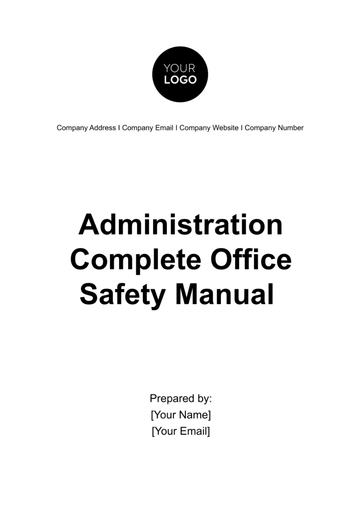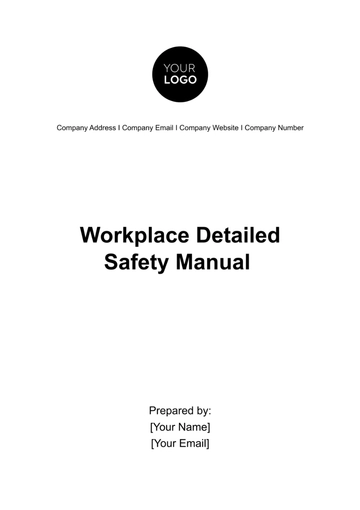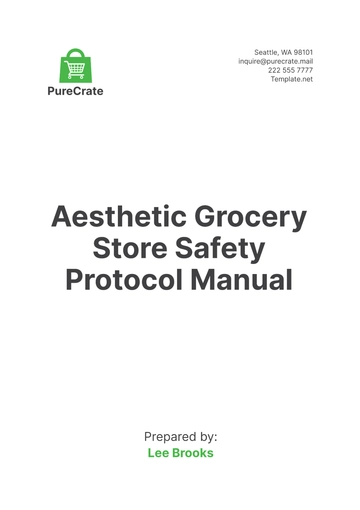Free Nursing Home Compliance Manual

I. Introduction
A. Purpose
The purpose of this Nursing Home Compliance Manual is to ensure [Your Company Name] adheres to all relevant regulations and standards to maintain the highest level of care and safety for residents. It serves as a comprehensive guide for employees to understand their responsibilities in maintaining compliance with regulatory requirements.
B. Scope
This manual applies to all employees and contractors of [Your Company Name] involved in the operation and management of nursing home facilities. It encompasses all aspects of compliance, including admission processes, resident care, staffing, documentation, and emergency preparedness.
C. Audience
This manual is intended for use by administrators, directors of nursing, nursing staff, caregivers, administrative staff, and any other personnel involved in compliance-related activities within [Your Company Name]'s nursing home facilities.
II. Regulatory Framework
A. Federal Regulations
Centers for Medicare & Medicaid Services (CMS)
[Your Company Name] complies with regulations set forth by CMS to participate in Medicare and Medicaid programs. These regulations govern various aspects of nursing home operations, including resident rights, quality of care, staffing requirements, and facility standards.
Health Insurance Portability and Accountability Act (HIPAA)
HIPAA regulations safeguard the privacy and security of protected health information (PHI). [Your Company Name] ensures compliance with HIPAA regulations to protect the confidentiality of resident health information and maintain their privacy rights.
B. State Regulations
[State Name] Department of Health Regulations
[Your Company Name] adheres to state-specific regulations governing nursing home facilities in [State Name]. These regulations cover licensing requirements, quality standards, resident care, staffing ratios, and other key aspects of nursing home operations.
C. Local Regulations
[County/City Name] Ordinances
In addition to federal and state regulations, [Your Company Name] complies with any local ordinances or regulations applicable to its nursing home facilities. These may include zoning regulations, building codes, fire safety standards, and other local requirements.
III. Compliance Policies and Procedures
A. Admission Process
Admission Criteria
[Your Company Name] establishes clear admission criteria to ensure that residents admitted to its nursing home facilities meet the appropriate level of care and are compatible with the services offered.
Assessment Procedures
Prior to admission, residents undergo comprehensive assessments conducted by qualified healthcare professionals to determine their physical, mental, and psychosocial needs.
Documentation Requirements
All necessary documentation, including medical records, consent forms, and insurance information, is collected and maintained in accordance with regulatory requirements.
B. Resident Care
Care Plans
Individualized care plans are developed for each resident based on their assessment and preferences, outlining specific goals, interventions, and approaches to meet their needs.
Medication Management
[Your Company Name] implements policies and procedures for safe medication management, including medication administration, storage, and reconciliation processes.
Fall Prevention
Measures are in place to assess and mitigate fall risks for residents, including environmental modifications, assistive devices, and staff education on fall prevention strategies.
C. Staffing
Staffing Ratios
[Your Company Name] maintains appropriate staffing ratios in accordance with regulatory requirements and industry standards to ensure resident safety and quality of care.
Qualifications and Training
Staff members are qualified and trained to perform their roles effectively, with ongoing education and professional development opportunities provided to enhance their skills and knowledge.
Staffing Policies
Policies and procedures govern staffing practices, including scheduling, shift assignments, and coverage during periods of increased demand or staff shortages.
D. Health and Safety
Infection Control
[Your Company Name] implements infection control measures to prevent the spread of infections among residents and staff, including hand hygiene protocols, personal protective equipment (PPE) use, and environmental cleaning procedures.
Emergency Preparedness
Emergency preparedness plans are in place to address potential emergencies, such as natural disasters or outbreaks of infectious diseases, ensuring the safety and well-being of residents and staff.
Environmental Safety
[Your Company Name] conducts regular assessments of the physical environment to identify and address safety hazards, such as tripping hazards, malfunctioning equipment, and inadequate lighting.
IV. Staff Training and Education
A. Orientation
New Employee Orientation
All new employees undergo comprehensive orientation training to familiarize them with [Your Company Name]'s mission, values, policies, and procedures.
Compliance Training
Orientation includes training on compliance-related topics, such as resident rights, infection control, HIPAA regulations, and emergency procedures.
B. Ongoing Training
Continuing Education
Staff members participate in ongoing training and professional development activities to maintain and enhance their skills, knowledge, and competencies.
In-Service Training
Regular in-service training sessions are conducted to address specific topics relevant to resident care, safety, and compliance.
C. Continuing Education
Continuing Education Opportunities
[Your Company Name] supports staff members in pursuing continuing education opportunities, such as workshops, seminars, webinars, and online courses, related to their roles and responsibilities.
Certification Programs
Staff members are encouraged to pursue relevant certifications in their respective fields to demonstrate competency and enhance career advancement opportunities.
V. Monitoring and Auditing
A. Internal Audits
Frequency
[Your Company Name] conducts regular internal audits to monitor compliance with policies, procedures, and regulatory requirements. Audits are conducted [frequency], with findings documented and reported to management.
Scope
Internal audits encompass various areas of nursing home operations, including resident care, documentation, medication management, infection control, and billing practices.
Audit Process
Audits are conducted by designated personnel or audit teams trained in auditing techniques. The process includes reviewing records, observing practices, interviewing staff, and assessing compliance with established standards.
B. External Audits
Regulatory Agency Audits
External audits may be conducted by regulatory agencies, such as CMS or state health departments, to assess [Your Company Name]'s compliance with federal and state regulations.
Accreditation Surveys
[Your Company Name] undergoes accreditation surveys by accrediting bodies, such as The Joint Commission or the Commission on Accreditation of Rehabilitation Facilities (CARF), to demonstrate adherence to industry standards and best practices.
Third-Party Audits
Periodically, [Your Company Name] may engage third-party audit firms to conduct independent audits of its operations, providing an objective assessment of compliance and identifying areas for improvement.
C. Corrective Actions
Action Plan Development
Upon completion of audits, [Your Company Name] develops action plans to address any identified deficiencies or non-compliance issues. Action plans include specific tasks, timelines, responsible parties, and measurable outcomes.
Implementation
Corrective actions are implemented promptly, with clear communication of expectations to staff members. Training may be provided to ensure staff understand and comply with revised policies or procedures.
Follow-Up
Follow-up procedures are established to monitor the effectiveness of corrective actions and ensure sustained compliance over time. Progress is tracked, and adjustments are made as needed to achieve desired outcomes.
VI. Reporting and Documentation
A. Incident Reporting
Reporting Requirements
Staff members are required to report any incidents or adverse events that occur within [Your Company Name]'s nursing home facilities. This includes falls, medication errors, resident abuse or neglect, and other incidents affecting resident safety or well-being.
Incident Reporting Form
An incident reporting form is used to document details of the incident, including date, time, location, individuals involved, and a description of what occurred. The form is submitted to management and/or the designated reporting authority for review and follow-up.
Investigation Process
Upon receipt of an incident report, [Your Company Name] initiates an investigation to determine the root cause of the incident and identify any contributing factors. The investigation may involve interviews, document review, and collaboration with relevant stakeholders.
B. Compliance Reporting
Reporting Channels
[Your Company Name] maintains reporting channels for employees to report suspected compliance violations or unethical behavior. This may include a confidential hotline, email address, or designated compliance officer.
Whistleblower Protections
Employees who report compliance concerns in good faith are protected from retaliation under [Your Company Name]'s whistleblower policy and applicable laws. Retaliation against whistleblowers is strictly prohibited and subject to disciplinary action.
Investigation and Resolution
Reports of compliance violations are promptly investigated by [Your Company Name]'s compliance team or designated individuals. Investigations are conducted impartially and thoroughly, with appropriate follow-up actions taken to address confirmed violations and prevent recurrence.
C. Recordkeeping
Documentation Requirements
Accurate and complete records of all compliance-related activities, including audits, investigations, training, and corrective actions, are maintained in accordance with regulatory requirements and [Your Company Name]'s policies.
Record Retention
Records are retained for the required retention period specified by federal, state, and local regulations. [Your Company Name] establishes procedures for the secure storage, retrieval, and disposal of records to ensure confidentiality and compliance with privacy laws.
VII. Communication
A. Internal Communication
Staff Meetings
Regular staff meetings are conducted to disseminate important information, discuss compliance-related topics, and provide updates on policies, procedures, and regulatory changes.
Communication Channels
[Your Company Name] utilizes various communication channels, such as email, intranet portals, bulletin boards, and staff newsletters, to ensure effective communication among team members.
Training Sessions
Internal training sessions are organized to educate staff members on compliance requirements, reinforce key policies and procedures, and address any questions or concerns they may have.
B. External Communication
Resident and Family Communication
[Your Company Name] maintains open and transparent communication with residents and their families regarding care plans, services, and any changes in policies or procedures that may affect them.
Regulatory Agencies
[Your Company Name] communicates with regulatory agencies in a timely and responsive manner, providing requested information, responding to inquiries, and addressing any compliance-related issues or concerns raised during inspections or audits.
Stakeholder Engagement
[Your Company Name] engages with external stakeholders, such as community organizations, advocacy groups, and healthcare partners, to foster collaboration, share best practices, and promote a culture of compliance and quality care.
VIII. Enforcement and Discipline
A. Policy Violations
Policy Enforcement
[Your Company Name] enforces compliance with policies and procedures through regular monitoring, audits, and staff education. Violations of policies are addressed promptly and consistently.
Disciplinary Measures
Disciplinary measures may be imposed for policy violations, ranging from verbal warnings and written reprimands to suspension or termination of employment, depending on the severity and recurrence of the violation.
Due Process
Employees are afforded due process rights when facing disciplinary action, including the opportunity to present their side of the story, provide evidence or witnesses, and appeal decisions through established grievance procedures.
B. Disciplinary Actions
Documentation
All disciplinary actions taken by [Your Company Name] are documented in the employee's personnel file, including the nature of the violation, the date and outcome of the disciplinary action, and any remedial measures or follow-up actions required.
Consistency
Disciplinary actions are administered consistently and fairly, without discrimination or favoritism. [Your Company Name] applies its disciplinary policies and procedures uniformly across all employees.
Rehabilitation and Support
In cases where employees demonstrate a willingness to improve and comply with policies, [Your Company Name] may offer rehabilitation and support measures, such as additional training, coaching, or counseling, to help them succeed in their roles.
C. Quality Improvement
Continuous Monitoring
[Your Company Name] continuously monitors its compliance efforts and quality of care through ongoing assessment, feedback mechanisms, and performance metrics.
Root Cause Analysis
When issues or deficiencies are identified, [Your Company Name] conducts root cause analyses to understand underlying causes and implement targeted interventions to address systemic issues and prevent recurrence.
Performance Improvement Plans
For areas needing improvement, [Your Company Name] develops performance improvement plans outlining specific goals, strategies, and timelines for improvement, with accountability assigned to responsible individuals or teams.
Resident Satisfaction Surveys
[Your Company Name] regularly solicits feedback from residents and their families through satisfaction surveys, focus groups, or interviews, using the feedback to identify areas for improvement and enhance the resident experience.
IX. Quality Improvement
A. Continuous Improvement
Quality Assurance Program
[Your Company Name] implements a comprehensive quality assurance program to monitor and improve the quality of care and services provided to residents. This program includes ongoing assessment, analysis, and action to address areas for improvement.
Performance Metrics
Key performance indicators (KPIs) are established to measure various aspects of nursing home operations, such as resident outcomes, satisfaction levels, staff performance, and compliance with regulatory requirements.
Data Collection and Analysis
Data on performance metrics are collected regularly from various sources, including resident records, incident reports, surveys, and audits. The data are analyzed to identify trends, patterns, and areas of concern.
Quality Improvement Initiatives
Based on data analysis, [Your Company Name] initiates quality improvement projects targeting specific areas for enhancement. These initiatives may include process improvements, staff training, policy revisions, or facility upgrades.
B. Resident Feedback
Feedback Mechanisms
[Your Company Name] provides multiple channels for residents and their families to provide feedback on their experiences, preferences, and concerns. These may include suggestion boxes, resident councils, satisfaction surveys, and one-on-one meetings.
Complaint Resolution
Complaints and concerns raised by residents or their families are addressed promptly and courteously by [Your Company Name]'s staff. A formal process is in place for investigating complaints, resolving issues, and communicating outcomes to the affected parties.
Resident Council
[Your Company Name] encourages resident participation in decision-making through resident councils or committees. These forums provide residents with a platform to voice their opinions, make suggestions, and collaborate with staff on quality improvement initiatives.
Satisfaction Surveys
Regular satisfaction surveys are conducted to assess resident and family satisfaction with various aspects of care and services, such as staff responsiveness, dining experiences, recreational activities, and overall quality of life. Results are used to inform quality improvement efforts and enhance resident satisfaction.
Survey Question | Strongly Agree | Agree | Neutral | Disagree | Strongly Disagree |
|---|---|---|---|---|---|
Staff are friendly and respectful | [70%] | [20%] | [5%] | [3%] | [2%] |
Facility is clean and well-maintained | [65%] | [25%] | [7%] | [2%] | [1%] |
Activities and programs meet my interests | [45%] | [35%] | [15%] | [3%] | [2%] |
Action Plans
Based on survey results and feedback received, [Your Company Name] develops action plans to address areas identified for improvement. These plans include specific goals, strategies, and timelines for implementation, with accountability assigned to designated individuals or teams.
Follow-Up and Evaluation
Progress on quality improvement initiatives and action plans is monitored closely, with regular follow-up and evaluation to assess effectiveness and make adjustments as needed. Results are communicated to residents, families, and staff to demonstrate commitment to continuous improvement.
- 100% Customizable, free editor
- Access 1 Million+ Templates, photo’s & graphics
- Download or share as a template
- Click and replace photos, graphics, text, backgrounds
- Resize, crop, AI write & more
- Access advanced editor
Maintain regulatory adherence with the Nursing Home Compliance Manual Template from Template.net. Editable and customizable, it compiles policies, procedures, and guidelines to ensure compliance in nursing home facilities. Tailor it effortlessly using our Ai Editor Tool for personalized manuals. Ensure transparency and consistency in compliance efforts with this essential template.





























